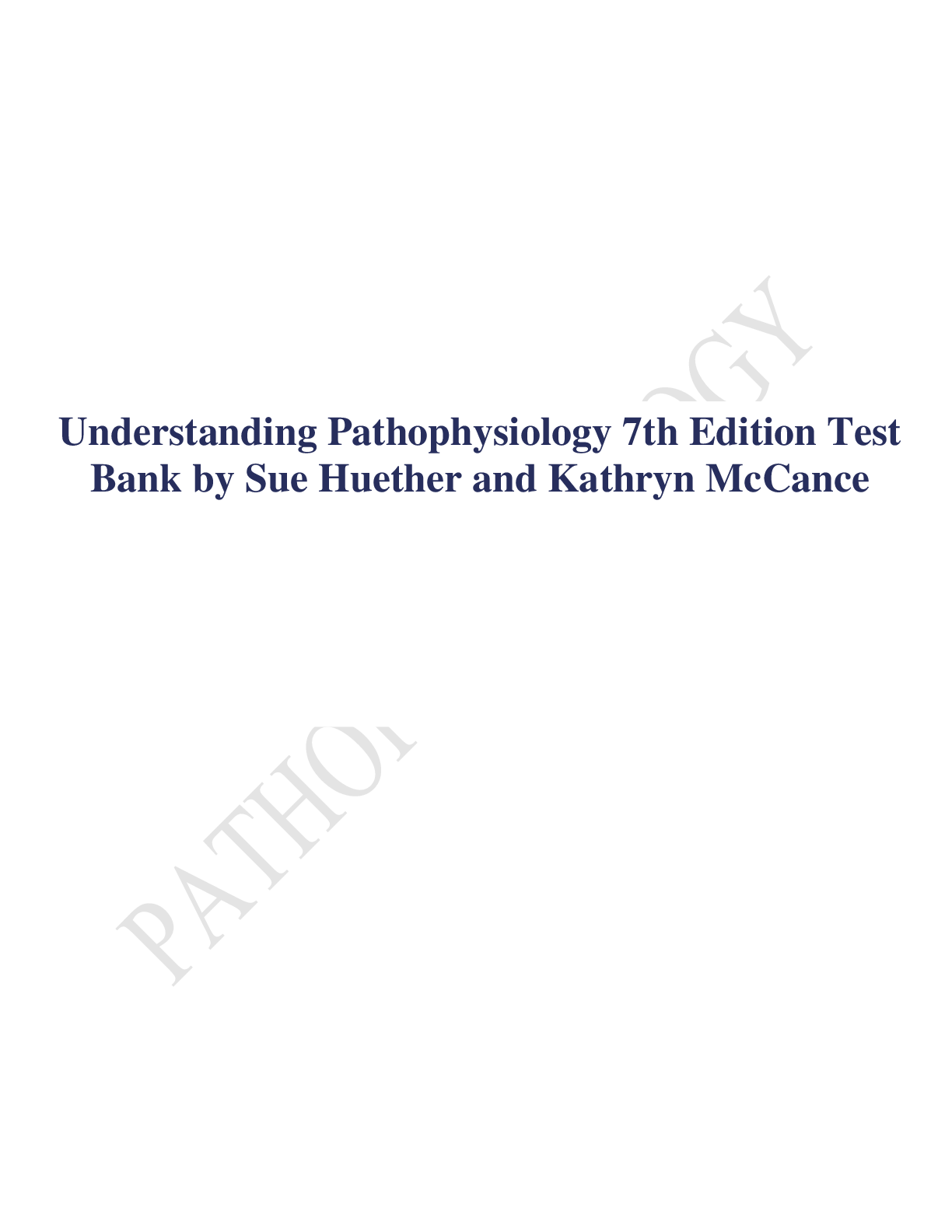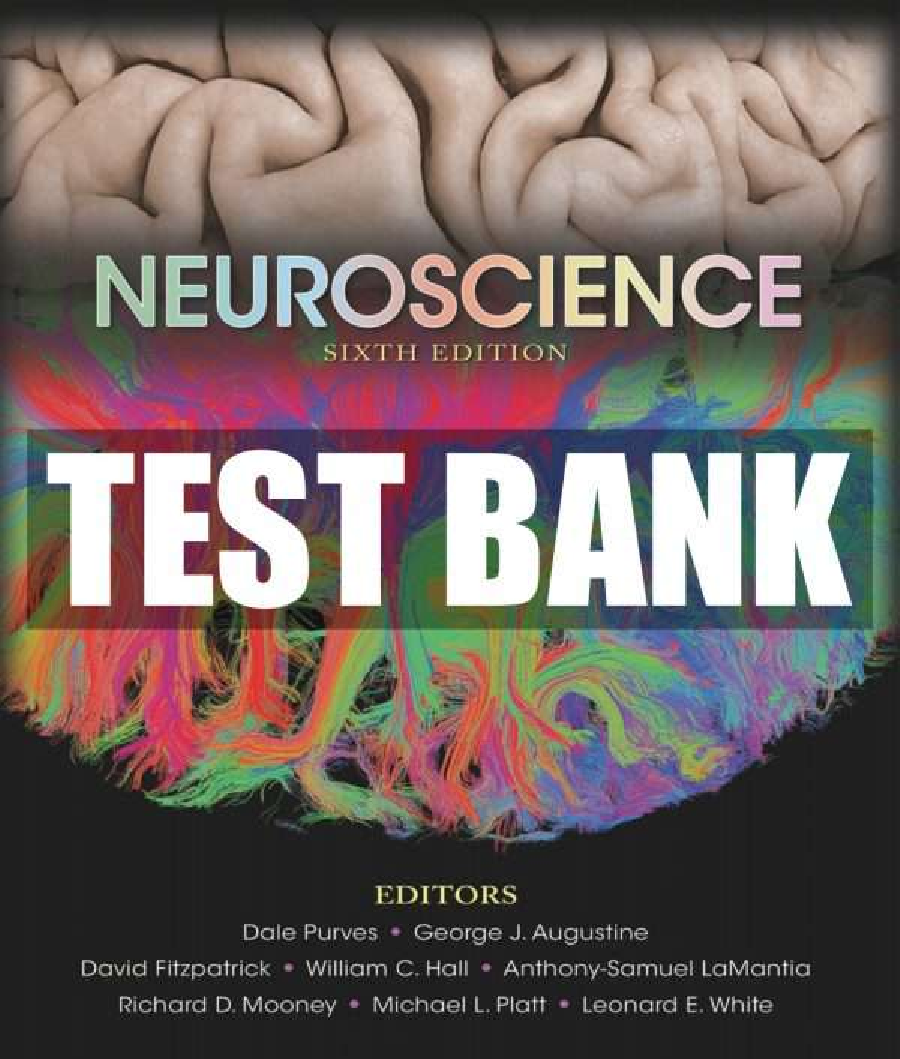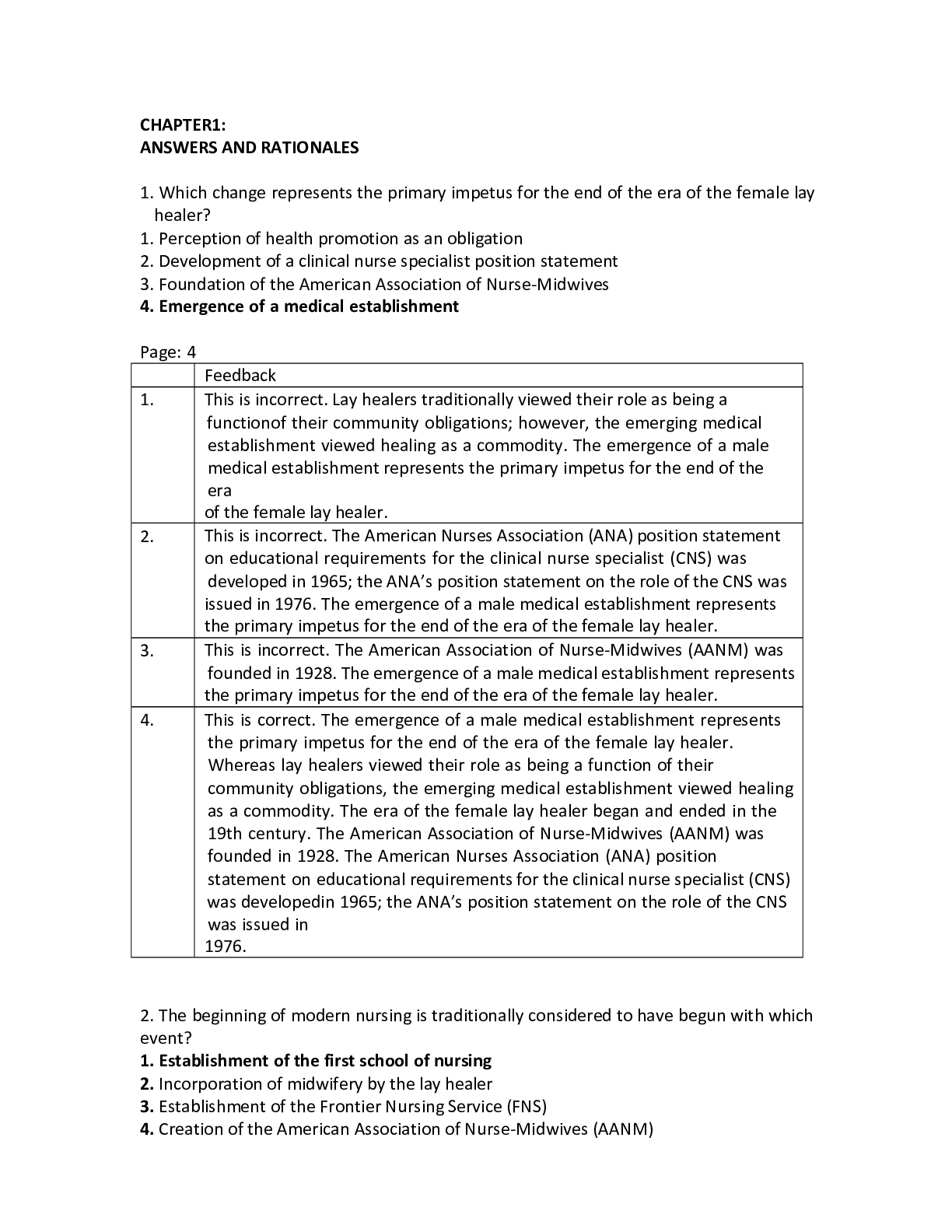*NURSING > TEST BANK > United States University> Complete Test Bank> ANSWERS AND RATIONALES FNP MSN 560 (All)
United States University> Complete Test Bank> ANSWERS AND RATIONALES FNP MSN 560
Document Content and Description Below
CHAPTER1: ANSWERS AND RATIONALES 1. Which change represents the primary impetus for the end of the era of the female lay healer? 1. Perception of health promotion as an obligation 2. Development of a ... clinical nurse specialist position statement 3. Foundation of the American Association of Nurse- Midwives 4. Emergence of a medical establishment Page: 4 Feedback 1. . Lay healers traditionally viewed their role as being a function of their community obligations; however, the emerging medical establishment viewed healing as a commodity. The emergence of a male medical establishment represents the primary impetus for the end of the era of the female lay healer. 2. . The American Nurses Association (ANA) position statement on educational requirements for the clinical nurse specialist (CNS) was developed in 1965; the ANA’s position statement on the role of the CNS was issued in 1976. The emergence of a male medical establishment represents the primary impetus for the end of the era of the female lay healer. 3. . The American Association of Nurse-Midwives (AANM) was founded in 1928. The emergence of a male medical establishment represents the primary impetus for the end of the era of the female lay healer. 4. The emergence of a male medical establishment represents the primary impetus for the end of the era of the female lay healer. Whereas lay healers viewed their role as being a function of their community obligations, the emerging medical establishment viewed healing as a commodity. The era of the female lay healer began and ended in the 19th century. The American Association of Nurse-Midwives (AANM) was founded in 1928. The American Nurses Association (ANA) position statement on educational requirements for the clinical nurse specialist (CNS) was developed in 1965; the ANA’s position statement on the role of the CNS was issued in 1976. 2. The beginning of modern nursing is traditionally considered to have begun with which event? 1. Establishment of the first school of nursing 2. Incorporation of midwifery by the lay healer 3. Establishment of the Frontier Nursing Service (FNS) 4. Creation of the American Association of Nurse-Midwives (AANM) Pages: 4–5 Feedback 1. Traditionally, modern nursing is considered to have begun in 1873, when the first three U.S. training schools for nurses opened. The role of the lay healer as a midwife is documented to have occurred in the 19th century, before the establishment of schools of nursing. The Frontier Nursing Service (FNS), which provided nurse-midwifery services, was established in 1925. In 1928, the Kentucky State Association of Midwives, which was an outgrowth of the FNS, became the American Association of Nurse-Midwives (AANM). 2. . The role of the lay healer as a midwife is documented to have occurred in the 19th century, before the establishment of schools of nursing. Traditionally, modern nursing is considered to have begun in 1873, when the first three U.S. training schools for nurses opened. 3. . The Frontier Nursing Service (FNS), which provided nurse- midwifery services, was established in 1925. Traditionally, modern nursing is considered to have begun in 1873, when the first three U.S. training schools for nurses opened. 4. . In 1928, the Kentucky State Association of Midwives, which was an outgrowth of the FNS, became the American Association of Nurse- Midwives (AANM). Modern nursing is considered to have begun in 1873, at which time the first three U.S. training schools for nurses opened. 3. In 1910, which factors most significantly influenced the midwifery profession? Select all that apply. 1. Strict licensing requirements 2. Negative public perception 3. Dedicated funding for training 4. Poor maternal-child outcomes 5. Mandatory professional supervision Pages: 6–7 Feedback 1. . In 1910, the midwifery profession was significantly influenced by poor maternal-child outcomes and a public perception as unprofessional. Though legislation ultimately was passed to tighten requirements related to licensing and supervision of midwives, in the early 20th century, midwives were largely unregulated and generally perceived as unprofessional. 2. In 1910, the midwifery profession was significantly influenced by poor maternal-child outcomes and a public perception as unprofessional. At that time, approximately 50% of all U.S. births were reportedly attended by midwives. However, especially with regard to perinatal health indicators, the national population’s general health was poor. Unfavorable outcomes among both mothers and infants were attributed to midwives who, at that time, were largely unregulated and generally perceived as unprofessional. Poor maternal-child outcomes, negative perceptions of midwives, obstetricians’ targeted efforts to take control of the birthing process, and a movement away from home births prompted major changes. Legislation was passed to tighten requirements related to licensing and supervision of midwives. One aim of the Sheppard-Towner Maternity and Infancy Act involved allotting funds to train public health nurses in midwifery; however, the bill lapsed in 1929. 3. . Goals of the Sheppard-Towner Maternity and Infancy Act included allocating funds to train public health nurses in midwifery, but the bill lapsed in 1929. In 1910, poor maternal-child outcomes and a public perception as unprofessional significantly influenced the midwifery profession. 4. In 1910, the midwifery profession was significantly influenced by poor maternal-child outcomes and a public perception as unprofessional. At that time, approximately 50% of all U.S. births were reportedly attended by midwives. However, especially with regard to perinatal health indicators, the national population’s general health was poor. Unfavorable outcomes among both mothers and infants were attributed to midwives who, at that time, were largely unregulated and generally perceived as unprofessional. Poor maternal-child outcomes, negative perceptions of midwives, obstetricians’ targeted efforts to take control of the birthing process, and a movement away from home births prompted major changes. Legislation was passed to tighten requirements related to licensing and supervision of midwives. One aim of the Sheppard-Towner Maternity and Infancy Act involved allotting funds to train public health nurses in midwifery; however, the bill lapsed in 1929. 5. . In 1910, the midwifery profession was largely unregulated. Factors that influenced the profession included poor maternal-child outcomes and a public perception as unprofessional. 4. Which advanced practice nursing role is unique in that the practitioners view their role as comprising a combination of two distinct disciplines? 1. Nurse practitioner 2. Certified registered nurse anesthetist 3. Clinical nurse specialist 4. Certified nurse-midwife Page: 9 Feedback 1. . The role of the certified nurse-midwife (CNM) is unique in that the CNM views the practice role as combining two disciplines: nursing and midwifery. 2. . The role of the certified nurse-midwife (CNM) is unique in that the CNM views the practice role as combining two disciplines: nursing and midwifery. 3. . The role of the certified nurse-midwife (CNM) is unique in that the CNM views the practice role as combining two disciplines: nursing and midwifery. 4. The role of the certified nurse-midwife (CNM) is unique in that the CNM views the practice role as combining two disciplines: nursing and midwifery. 5. In the 19th century, which factors led to the administration of anesthesia by nurses? Select all that apply. 1. Surgeon entitlement to collecting anesthesia fees 2. Collaborative practice between physician-anesthetists and nurses 3. Lack of recognition of anesthesiology as a medical specialty 4. Opposition to anesthesia administration by physicians 5. Formation of a national organization by nurse anesthetists , 3 Pages: 10–11 Feedback 1. In the 19th century, anesthesia was in its early stages. Because of a lack of recognition as a medical specialty and the surgeon’s entitlement to collecting anesthesia fees, other physicians had little to no interest in anesthesia administration. However, physicians were not opposed to administering anesthesia; rather, anesthesia was viewed as a means by which to transform surgery into a scientific modality for treating health alterations. Collaboration between physicians and nurses did not contribute to administration of anesthesia by nurses; contentiousness is a hallmark of the relationship between nurse anesthetists and anesthesiologists even in the present day. In the 19th century, no national organization of nurse anesthetists yet existed. The National Association of Nurse Anesthetists, which was renamed the American Association of Nurse Anesthetists (AANA), was founded in 1931. 2. . With the introduction of anesthesia, collaboration between physicians and nurses did not contribute to administration of anesthesia by nurses. By contrast, contentiousness is a hallmark of the relationship between nurse anesthetists and anesthesiologists even in the present day. In the 19th century, anesthesia was in its early stages. Administration of anesthesia by nurses occurred primarily because of anesthesiology’s lack of recognition as a medical specialty and the surgeon’s entitlement to collecting anesthesia fees. 3. In the 19th century, anesthesia was in its early stages. Because of a lack of recognition as a medical specialty and the surgeon’s entitlement to collecting anesthesia fees, other physicians had little to no interest in anesthesia administration. However, physicians were not opposed to administering anesthesia; rather, anesthesia was viewed as a means by which to transform surgery into a scientific approach to treating with health alterations. Collaboration between physicians and nurses did not contribute to administration of anesthesia by nurses; contentiousness is a hallmark of the relationship between nurse anesthetists and anesthesiologists even in the present day. In the 19th century, no national organization of nurse anesthetists yet existed. The National Association of Nurse Anesthetists, which was renamed the American Association of Nurse Anesthetists (AANA), was founded in 1931. 4. . In the 19th century, anesthesia was in its early stages. Physicians were in favor of the administration of anesthesia, viewing this advancement as a means by which to transform surgery into a scientific modality for treating health alterations. Because of a lack of recognition as a medical specialty and the surgeon’s entitlement to collecting anesthesia fees, other physicians had little to no interest in anesthesia administration. As such, the administration of anesthesia was assigned to nurses. 5. . The National Association of Nurse Anesthetists, which was renamed the American Association of Nurse Anesthetists (AANA), was founded in 1931. In the 19th century, anesthesia was in its early stages. Because of a lack of recognition as a medical specialty and the surgeon’s entitlement to collecting anesthesia fees, other physicians had little to no interest in anesthesia administration. Thus, anesthesia administration was performed by nurses. 6. Which factor contributed to expansion of the role of the clinical nurse specialist (CNS) during the 1960s? 1. Increased numbers of practicing physicians 2. Tightening of female role definitions 3. Return of nurses from military conflict 4. Lack of medical specialization Page: 17 Feedback 1. . During the 1960s, a shortage of physicians occurred. The role of the CNS was expanded in part because of the return of nurses from the Vietnam War. Nurse veterans searched for opportunities to increase their knowledge and skills, and practiced in advanced roles as well as nontraditional specialties (such as anesthesia and trauma or anesthesia). 2. . During the 1960s, role definitions for women became less restrictive. The role of the CNS was expanded in part because of the return of nurses from the Vietnam War. Nurse veterans searched for opportunities to increase their knowledge and skills, and practiced in advanced roles as well as nontraditional specialties (such as anesthesia and trauma or anesthesia). 3. Expansion of the CNS role during the 1960s occurred in part because of the return of nurse veterans from the Vietnam War who sought to increase their knowledge and skills, and to work in advanced roles and nontraditional fields, such as anesthesia and trauma. 4. . In the 1960s, medical specialization was prevalent, and the need for competent nurses who were proficient at caring for patients with complex health needs increased. Thus, the CNS role expanded. The role of the CNS also expanded because of the return of nurses from the Vietnam War. Many of these nurse veterans searched for opportunities to increase their knowledge and skills, and practiced in advanced roles as well as nontraditional specialties (such as anesthesia and trauma or anesthesia). 7. Differentiation between the role of the clinical nurse specialist (CNS) and the nurse practitioner (NP) is primarily based on which premise? 1. Designation as an advanced practice nurse 2. Diagnosis of patient health conditions 3. Nature of practice setting environments 4. Authority to prescribe medications Pages: 20–21 Feedback 1. . Both the clinical nurse specialist (CNS) and the nurse practitioner (NP) are designated as advanced practice nurses (APNs). A primary differentiation between the roles of CNS and NP centers on the nature of the practice setting. Although the CNS most often practices in a secondary or tertiary care setting, the NP often practices in a primary care setting. 2. . Both the clinical nurse specialist (CNS) and the nurse practitioner (NP) are prepared to diagnose patient health alterations. A primary differentiation between the roles of CNS and NP centers on the nature of the practice setting. Although the CNS most often practices in a secondary or tertiary care setting, the NP often practices in a primary care setting. 3. A primary differentiation between the roles of clinical nurse specialist (CNS) and nurse practitioner (NP) centers on the nature of the practice setting. Although the CNS most often practices in a secondary or tertiary care setting, the NP often practices in a primary care setting. Both the CNS and the NP are designated as advanced practice nurses (APNs), educationally prepared to diagnose patient health alterations, and eligible to apply for prescriptive authority. 4. . Both the clinical nurse specialist (CNS) and the nurse practitioner (NP) are eligible to apply for authority to prescribe medications. A primary differentiation between the roles of CNS and NP centers on the nature of the practice setting. Although the CNS most often practices in a secondary or tertiary care setting, the NP often practices in a primary care setting. 8. The National Council of State Boards of Nursing’s Consensus Model for Advanced Practice Registered Nurse (APRN) Regulation prompted gains related to which aspects of the role and function of the nurse practitioner (NP)? Select all that apply. 1. Legal authority 2. Reimbursement 3. Consumer recognition 4. Prescriptive privilege 5. Autonomy , 2, 4 Page: ................CONTINUES............DOWNLOAD TO BOOST YOUR GRADES....... [Show More]
Last updated: 1 year ago
Preview 1 out of 147 pages

Buy this document to get the full access instantly
Instant Download Access after purchase
Add to cartInstant download
We Accept:

Reviews( 0 )
$17.00
Document information
Connected school, study & course
About the document
Uploaded On
May 12, 2021
Number of pages
147
Written in
Additional information
This document has been written for:
Uploaded
May 12, 2021
Downloads
0
Views
37
















